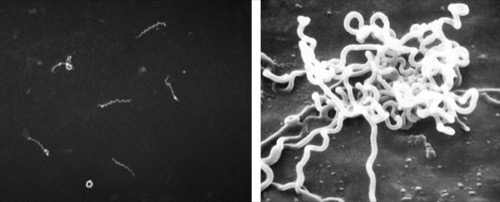You are here: Urology Textbook > Penis > Sexually transmitted diseases > Syphilis > Pathogen and symptoms
Syphilis: Epidemiology, Pathogen, Signs and Symptoms
- Syphilis: Etiology, Signs and Symptoms
- Syphilis: Diagnosis and Treatment
Definition
Syphilis is a chronic infectious disease caused by Treponema pallidum, which is divided into stages based on the clinical findings. Early syphilis stages occur within two years after infection and include primary syphilis with chancre, secondary syphilis (mucocutaneous lesions), and an asymptomatic early latent syphilis stage. Late syphilis stages (after two years of infection) include an asymptomatic late latent syphilis stage and tertiary syphilis (organ manifestation after latency).
Epidemiology of Syphilis
Europe and USA:
Declining frequency, the incidence of syphilis dropped in the last decades from 20/100000 to 3–5/100000 for primary and secondary syphilis. Since 2000, there has been a rising incidence, especially in risk groups for syphilis: young sexually active people with multiple partners, no condom use, men who have sex with men, and low social status. In Germany, the incidence in 2018 was 9/100.000. In the USA, the incidence in 2021 was 50/100.000. The risk for congenital syphilis correlates with the incidence of syphilis in young women with huge differences between countries: in Europe, 2/100.000 live births, and in the USA 78/100.000 live births.
Developing world:
There is a high prevalence of untreated syphilis, with a high risk of congenital syphilis and relevant mortality.
Etiology of Syphilis
Pathogen:
Syphilis is caused by Treponema pallidum, a bacterial spirochete. So far, Treponema pallidum cannot be cultured.
Morphology of Treponema pallidum:
15 μm long, spiral bacteria, visible in the dark field microscopy with screw-like motions [fig. Treponema pallidum].
 |
Transmission of syphilis:
Syphilis is transmitted through direct mucous membrane contact. Infection occurs in up to 30% of sexual intercourse with an infected partner. A transmission is even possible with less intensive contact. Rare transmissions: intrauterine, perinatally, or through blood transfusion.
Pathology, Signs and Symptoms of Syphilis
Pathology
The infection of endothelial cells leads to endarteritis obliterans and periarteritis with plasmacytic infiltration. Due to cellular immune mechanisms, granulomas develop in the further course of disease.
Symptoms of Primary Syphilis
Chancre:
The primary lesion (genital or oral ulcus) occurs with an incubation period of 10–90 days. The ulcus (also called chancre) is a firm, painless ulceration, 5–15 mm and sharply demarcated. Often, a painless inguinal lymphadenopathy can be observed.
| Do you want to see the illustration? Please support this website with a Steady membership. In return, you will get access to all images and eliminate the advertisements. Please note: some medical illustrations in urology can be disturbing, shocking, or disgusting for non-specialists. Click here for more information. |
Symptoms of Secondary Syphilis
Symptoms of secondary syphilis develop six weeks to several months after untreated primary syphilis.
- General symptoms: Fever, arthralgia, and weight loss.
- Mucocutaneous lesions: maculopapular, papular, pustular, or squamous types of rash. Many dermatologic diseases look similar.
- Condyloma lata: painless warts or moist erosions in the genital and perianal region. The lesions contain Treponema pallidum and are highly infectious.
| Do you want to see the illustration? Please support this website with a Steady membership. In return, you will get access to all images and eliminate the advertisements. Please note: some medical illustrations in urology can be disturbing, shocking, or disgusting for non-specialists. Click here for more information. |
Latent Syphilis
Serologic evidence for syphilis without any clinical signs of infection is called latent syphilis. If the initial infection of syphilis is suspected to be within the last two years, early latent syphilis is probable. If the initial infection is suspected to have occurred more than two years ago, late latent syphilis is diagnosed.
Symptoms of Tertiary Syphilis
Tertiary syphilis develops after untreated latent syphilis with onset in different organ systems:
- Skin: brown nodules of the skin
- Aortic aneurysm: is caused by endarteritis of the vasa vasorum.
- Gumma: granulomas in bone, skin and mucous membranes. Cutaneous gumma may ulcerate.
- Neurosyphilis: possible are meningitis, hemiplegia, epilepsy, progressive paralysis (cerebral atrophy, dementia, psychosis), tabes dorsalis (gait ataxia, bladder dysfunction).
- Eyes: uveitis, retinitis and neuritis of the optic nerve.
Congenital Syphilis
Maternal infection increases the risk of a miscarriage, a stillbirth, or the birth of a child with congenital syphilis. The probability of vertical transmission amounts to 80–90% in primary syphilis, 40% in early latent syphilis, and 10% in late latent syphilis.
In infants (0–2 years), early congenital syphilis manifests with poor feeding, rhinitis, hepatosplenomegaly, pseudoparalysis, and various lesions of the skin. However, the children may be asymptomatic and diagnosed only by screening.
Late congenital syphilis (age over two years) manifests with a saddle nose, skin lesions, and rarely with the Hutchinson triad (deafness, Hutchinson teeth (notched incisor teeth), and keratitis).
| NGU Urethritis | Index | Syphilis: Treatment |
Index: 1–9 A B C D E F G H I J K L M N O P Q R S T U V W X Y Z
References
Deutsche STI-Gesellschaft (DSTIG): Diagnostik und Therapie der Syphilis. 2021. https://register.awmf.org/assets/guidelines/059-002l_S2k_Diagnostik_Therapie_Syphilis_2021_06.pdf
Center for Disease Control and Prevention: “Sexually Transmitted Infections (STI) Treatment Guidelines,” 2021. [Online]. Available: https://www.cdc.gov/std/treatment-guidelines/STI-Guidelines-2021.pdf
IUSTI, European guidelines on the management of syphilis. https://iusti.org/wp-content/uploads/2020/11/2020-Syphilis-guideline.pdf
Robert-Koch-Institut: RKI-Ratgeber Syphilis. https://www.rki.de/DE/Content/Infekt/EpidBull/Merkblaetter/Ratgeber_Syphilis.html
 Deutsche Version: Erreger und Symptome der Syphilis (Lues)
Deutsche Version: Erreger und Symptome der Syphilis (Lues)